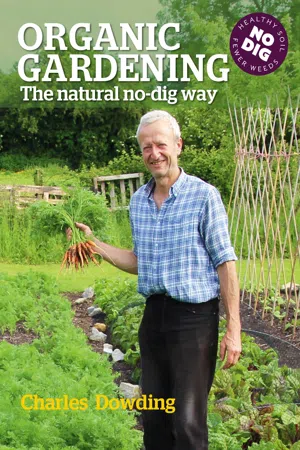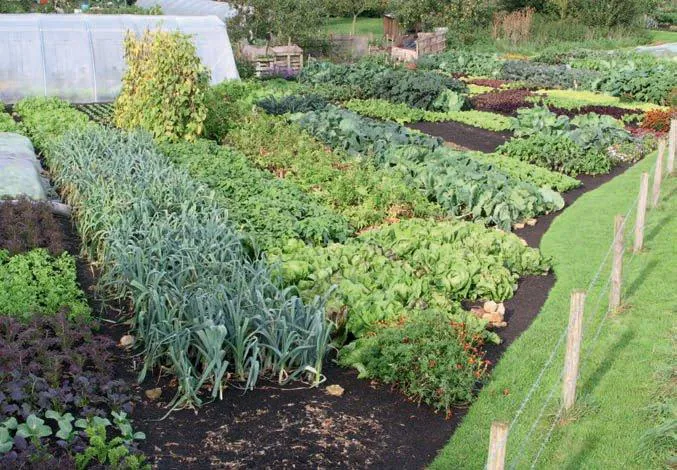
eBook - ePub
Organic Gardening
The Natural No-Dig Way
Charles Dowding
This is a test
- 272 pages
- English
- ePUB (mobile friendly)
- Available on iOS & Android
eBook - ePub
Organic Gardening
The Natural No-Dig Way
Charles Dowding
Book details
Book preview
Table of contents
Citations
About This Book
In this edition of Organic Gardening, Charles Dowding (the guru of no dig gardening), Charles shares his organic, no-dig approach to soil and plants, revealing the range of techniques that enable him to grow healthy, vibrant crops while, with sustainability in mind, maintaining a healthy soil. His success is based on these key principles: No-dig, Spread organic matter on the soil surface, Clean & improve the soil in the first 3-12 months, and Weed every 10 days or so, when weeds are small. By using a system of permanent, slightly raised beds, Charles shows how to grow a delicious variety of fruit and vegetables organically: what to choose; when to sow, plant and harvest; and how best to avoid pests and diseases.
Frequently asked questions
How do I cancel my subscription?
Can/how do I download books?
At the moment all of our mobile-responsive ePub books are available to download via the app. Most of our PDFs are also available to download and we're working on making the final remaining ones downloadable now. Learn more here.
What is the difference between the pricing plans?
Both plans give you full access to the library and all of Perlego’s features. The only differences are the price and subscription period: With the annual plan you’ll save around 30% compared to 12 months on the monthly plan.
What is Perlego?
We are an online textbook subscription service, where you can get access to an entire online library for less than the price of a single book per month. With over 1 million books across 1000+ topics, we’ve got you covered! Learn more here.
Do you support text-to-speech?
Look out for the read-aloud symbol on your next book to see if you can listen to it. The read-aloud tool reads text aloud for you, highlighting the text as it is being read. You can pause it, speed it up and slow it down. Learn more here.
Is Organic Gardening an online PDF/ePUB?
Yes, you can access Organic Gardening by Charles Dowding in PDF and/or ePUB format, as well as other popular books in Ciencias biológicas & Horticultura. We have over one million books available in our catalogue for you to explore.
Information
Topic
Ciencias biológicasSubtopic
HorticulturaPART 1
Letting nature nurture your garden

CHAPTER 1
The art of not digging

Abundant growth in clay soil, undug for 11 years.
The popularity of soil cultivation, and the common conviction that digging is absolutely necessary to grow vegetables and many other plants, shows how habits can become powerfully ingrained. Let us ask what digging and rotovating are supposed to do:
- loosen the soil so that roots can more easily travel through as plants grow
- incorporate manures and compost
- remove and/or bury weeds to clean the soil
- create a tilth for sowing.
I now consider each point in turn from the perspective of a confirmed, long-standing no-digger, who finds these arguments very puzzling and somewhat contradictory, as well as responsible for causing some damage to the soil.
Soil loosening
Firm soil (not the same as compact soil) grows great plants. But if your soil really is so hard that plant roots cannot penetrate, then something has gone so badly wrong that mere digging will probably be a temporary solution. It would be more productive to ask: Why is my soil so hard?
A possible answer could be that you live in a new house and the garden was recently a building site, so that it is full of rubble underneath and has some dubious topsoil above. The clear solution in this case is to import a large quantity of compost – up to 15cm (6") initially – which will serve to create a much softer, more fertile, lively and true topsoil above the existing topsoil, which should probably have been classed as subsoil anyway. The word ‘topsoil’ is often inaccurate and much of it is pretty dead – for instance, if it has been kept for too long in a heap so that worms have disappeared. Soil is not a commodity that can be stacked, stored and shipped around. Soil can also suffer from being walked on in wet weather – a sound reason for having permanent beds and pathways.
It is worms and their lively allies in a living soil who are going to do your digging, on a permanent and ongoing basis, far more thoroughly and productively than any spading or forking can achieve. Worms need food: any decaying organic matter which they turn into humus, another name for which is ‘black gold’ because it is the source of all that is best in plant growth. Even the worst soils have a few worms in there somewhere, so annual mulches of 5cm (2") of compost above them will provide the cool, dark, moist humus-potential that they thrive in and on. Quite soon your worm population will be increasing, and plants will start to grow – including weeds, but they should be easy to pull out of the crumbly compost.
Results in the first season of using compost on very poor subsoil may be only fair, yet all the time you are building for the future. Each year’s crops are an increasingly interesting dividend, while the real wealth is in your soil, a balance of health and fertility that increases all the time.
In terms of fertility, chemical farmers and gardeners tend to concentrate on the requirements of individual plants. One encounters phrases such as ‘potatoes are heavy feeders’. Sometimes this can become complicated, as conventional wisdom dictates a different ‘feeding regime’ for each kind of vegetable. Things are much simpler for a composting no-digger, who is simply looking all the time to improve the soil and holds an understanding that well-structured, undisturbed soil has a balance of possibilities that will serve any crop. ‘Feed the soil, not the plant’ is another way of looking at it.
Incorporating manure or compost
Do we need to ‘incorporate’ our compost or animal manure or whatever organic addition we are bringing to the garden? Thirty years of not doing so, on a range of soils and in different conditions, convinces me that there is absolutely no need to ‘dig manures in’ as so many gardeners do, and advise others to do, taking it for granted that it is automatically right and makes perfect sense.
In fact it makes little sense, and I find that results are better from surface application, since that is how nature works. Falling leaves are pulled in by worms, as are many other pieces of surface debris. Charles Darwin describes the worms’ approach quite beautifully in his 1882 book The Formation of Vegetable Mould Through the Action of Worms, with Observations of Their Habits, where he comes to the conclusion that earthworms add between 2.5-5cm (1-2") of topsoil a year in healthy pasture, as they secrete their fertile ‘casts’ at surface level. This is one reason why archaeologists have to dig so deep.

Spreading year-old cow manure on low beds of clay soil.
I find that quite soon after applying a 2.5-5cm (1-2") dressing of well-rotted manure or compost on top of the soil, it starts, quite simply, to disappear. Sometimes on hungry soils, it is all gone within a few months and the soil is visible again, only a little darker, more friable and richer, with many crumbly and humus-rich worm casts. On fertile soil, the surface compost takes longer to disappear –a sign of health. Ideally, when compost is applied two or three months before sowing or planting, it will be sufficiently broken up and dispersed, or will have disappeared into the soil when our seeds or plants are ready. The soil will be thoroughly ready to receive them.
Occasionally, if time is short, plants can be set into recently composted soil, as long as the compost is not too rough; otherwise there is a risk of slug damage from the slimy beasts hiding under large lumps of half-decayed compost. Any lumpy compost tends to break down best on top of soil rather than being left in a heap, so it is best spread in late autumn or winter, well before planting time.
The other significant danger from digging manures or compost into the soil is ‘nitrogen robbery’. Think of the woodier, tougher, fibrous bits of compost as rich in carbon and needing nitrogen to break down into humus. On top they do this quite slowly, helped by the weather, but inside the soil they are known to use the surrounding soil nutrients, which would otherwise be available to plants, to finish their rotting down. Hence a golden piece of advice is to never dig sawdust into the soil. Its large surface area of wood can absorb huge amoun...
Table of contents
- Cover
- Reviews of previous editions
- Title Page
- Contents
- Acknowledgements
- Preface to the third edition
- Foreword
- Introduction: Organic is … simple, natural practices
- PART 1: Letting nature nurture your garden
- PART 2: Healthy harvests
- Postscript: The answer is in the soil!
- Appendix: Dig/no-dig experiment at Lower Farm, Somerset
- Resources
- Bibliography
- Index
- Copyright
- Advertisement